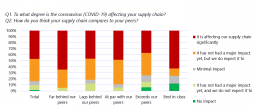At a time of accelerated disruption fueled by global events and challenges such as trade wars, environmental changes, the COVID-19 pandemic, and regulatory demands, global manufacturing supply chains face unprecedented pressure. Though we’ve seen many local disruptions with a global impact, COVID-19 is the first truly global disruption in decades.
The crisis has exposed manufacturing supply chains’ lack of preparedness to deal with the outbreak and its far-reaching consequences, including quarantines, social distancing, and travel restrictions.
Most European Supply Chains Impacted by COVID-19
According to IDC’s Supply Chain Survey, fielded in late March/early April, 84% of European manufacturers reported severe supply chain disruptions or said they expected to face them in the future. Moreover, the majority of manufacturers had to reduce or even entirely stop their production, while others managed to switch their production to ventilators or personal protective equipment to meet humanitarian needs. Unlike the 2008/2009 financial crisis, however, when the impact on manufacturing was gradual, COVID-19 caused sudden changes and resulted in disconnections of “traditional” supply chains.
We also investigated whether supply chain maturity makes a difference in terms of impact experienced (see figure). The results show that even European manufacturers that believe they have best-in-class supply chains were not spared by COVID, though they exhibited more resiliency (green) and less uncertainty (orange) than their peers. Worryingly, however, the majority of manufacturers struggled with supply chain visibility, preventing them from assessing the impact of COVID on their supply chains.
Supply Chain Gaps: Even the Best Have Work to Do
Manufacturers admit they have work to do to improve their supply chains and make them more resilient to future disruption, and we see differences in their approaches based on supply chain maturity. Manufacturers with less advanced supply chains struggle mostly with lack of supply chain visibility and flexibility, and, related to that, a poor pipeline of new products.
These manufacturers also report having to improve their ability to get products to market fast enough. In the current situation, laggards are struggling to get things done.
Manufacturers with best-in-class supply chains are also struggling here, but to a much lesser degree. For these manufacturers, the more pressing need is to drive collaboration with external suppliers and customers and develop digital capabilities to transition their supply chains to new business models.
Unlike laggards that are still focusing on getting their basics right, supply chain leaders look to have mastered this and are now focusing on next-generation improvements.
But how exactly are they doing this, and what role does technology play?
Technology’s Role in Driving Supply Chain Visibility
When we asked European manufacturers which major technologies they were using to drive visibility on their supply chains, we found that leaders have a greater propensity than laggards to use enterprise resource planning (ERP) for this purpose. Visibility is key to buffering the sudden disruptions brought by COVID-19 on manufacturing business processes.
We also correlated the use of major technologies against the degree to which manufacturers found themselves to be impacted by the pandemic. This revealed that companies that have seen minimal impact were also choosing ERP over other major technologies to achieve visibility.
This is because ERP provides end-to-end visibility by organizing data in a consistent and homogeneous way across different business processes, enabling companies to dismantle silos and enable collaborative processes. These companies also rely on electronic data interchange (EDI) and supplier/customer portals to create a truly intra-/inter-enterprise information flow and decision-making environment.
On the other hand, companies that have been significantly affected and those not yet able to assess the impact of the crisis on their processes (and therefore living under constant uncertainty) appear to make much greater use of enterprise collaboration tools and best-of-breed applications for visibility. These companies tend to rely less on ERP for visibility.
Best-of-breed applications are very good at managing specific applications and processes and providing users with a degree of visibility over their processes. But relying on several best-of-breed applications does not deliver the end-to-end visibility required to address sudden and complex business disruptions.
DAE: Connecting Technology Providers and Manufacturing Executives
There are many other technologies out there that can help manufacturing supply chains prepare for the next normal and brace themselves for future disruptions.
To encourage dialog between manufacturing companies and technology providers on how to tackle this next normal, IDC is launching Digital Accelerate Events (DAE) as a content marketing platform to support relationship building and lead generation.
IDC’s Digital Executive Manufacturing Forum, to be held on November 24 on the DAE platform, will provide a great opportunity for manufacturing executives to discuss key issues such as defining new partnerships and building the pipelines for their future businesses.


